Analyzing Consumer Behaviour in the Hospitality Industry
VerifiedAdded on 2021/02/19
|8
|2397
|86
Report
AI Summary
This report provides an analysis of consumer behavior within the hospitality industry, using the Hilton Hotel as a case study. It evaluates various cultural, personal, social, and psychological factors influencing consumer decisions, including the impact of digital technology on changing customer trends. The report outlines the steps in the consumer decision-making journey, differentiating between Business-to-Consumer (B2C) and Business-to-Business (B2B) processes. It also explores how marketers can influence different stages of the decision-making process with specific examples from the hospitality sector, and it touches upon primary and secondary research methods used in market analysis. The conclusion summarizes the key factors impacting consumer behavior and the role of digital platforms in promoting hotels and services.
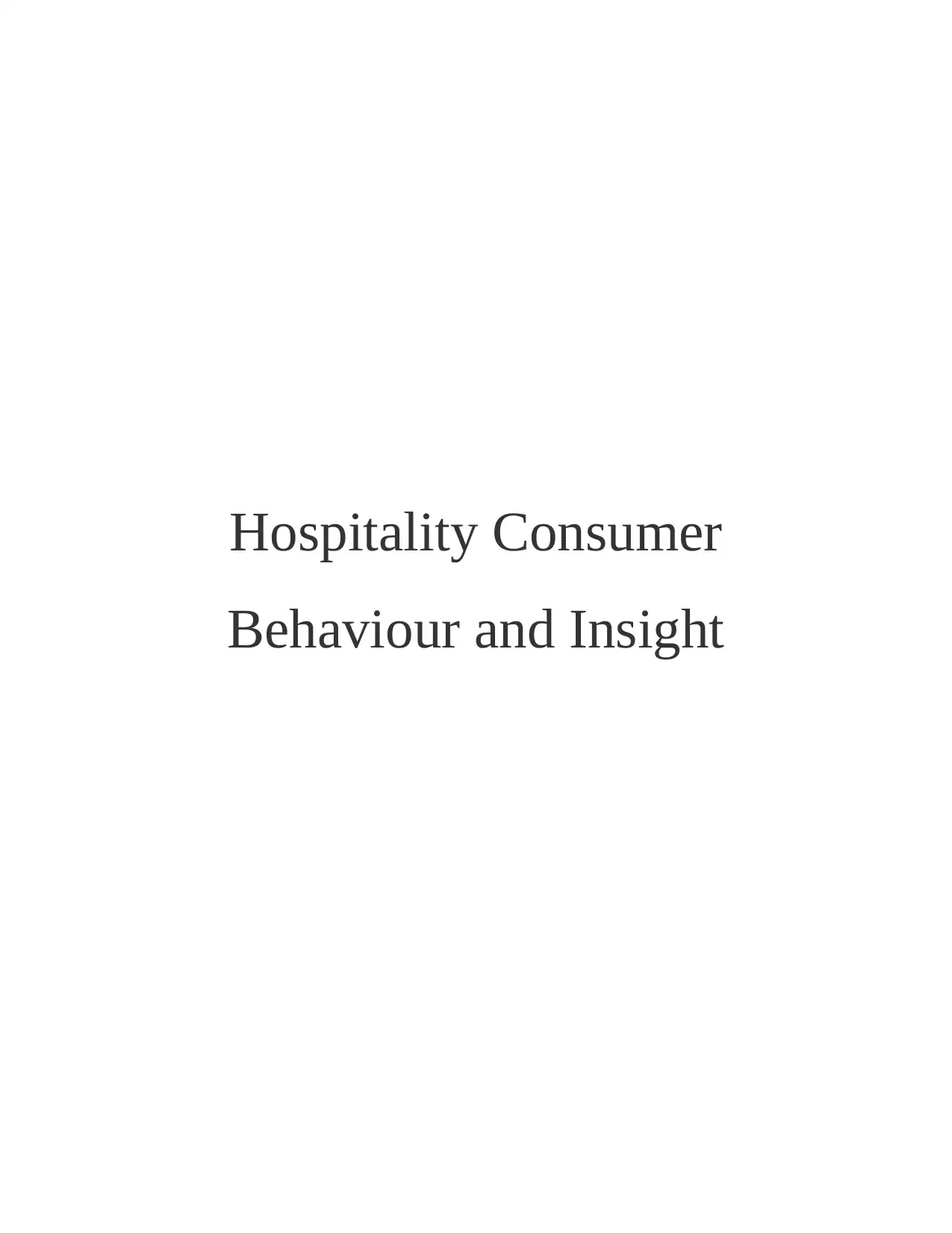
Hospitality Consumer
Behaviour and Insight
Behaviour and Insight
Paraphrase This Document
Need a fresh take? Get an instant paraphrase of this document with our AI Paraphraser
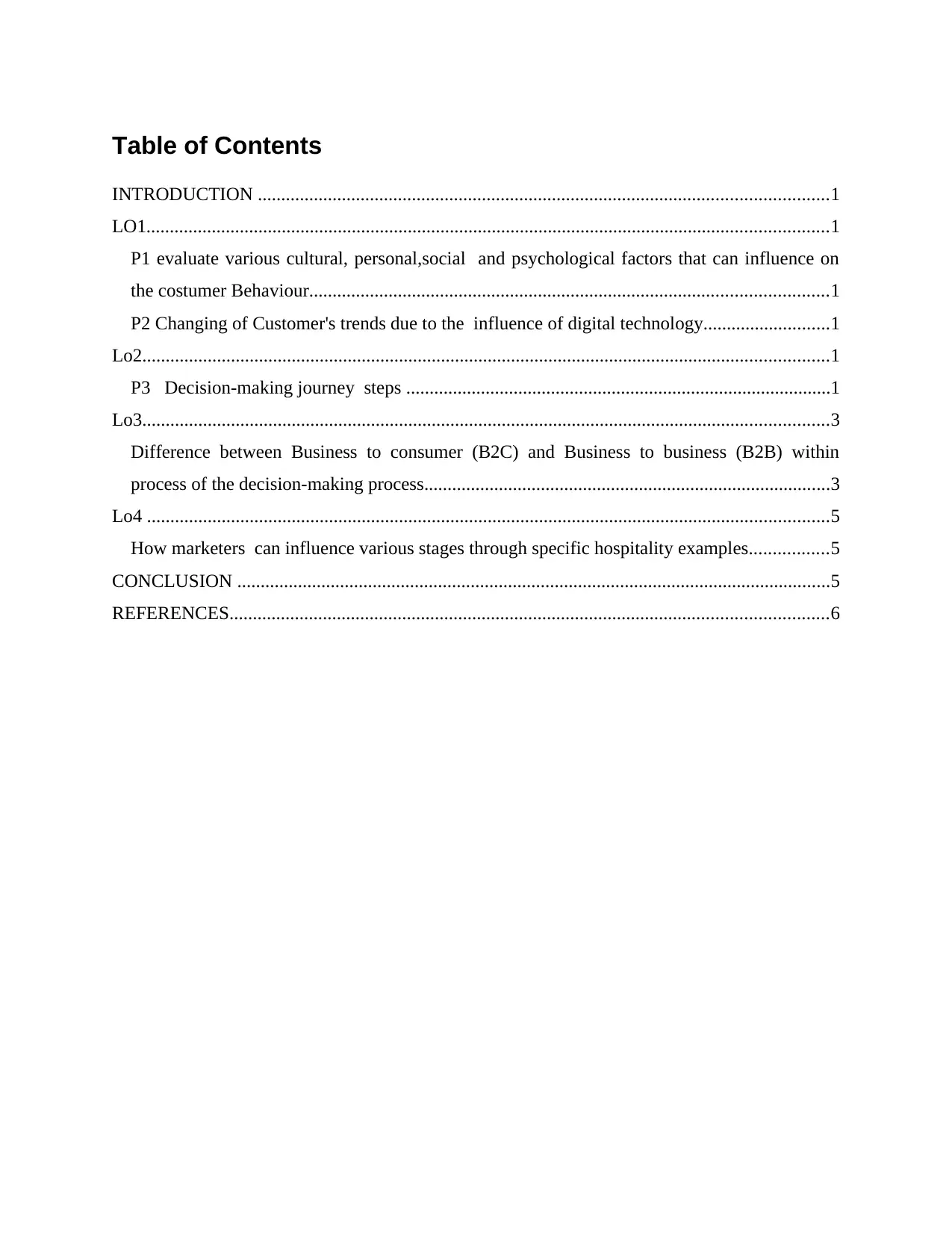
Table of Contents
INTRODUCTION ..........................................................................................................................1
LO1..................................................................................................................................................1
P1 evaluate various cultural, personal,social and psychological factors that can influence on
the costumer Behaviour...............................................................................................................1
P2 Changing of Customer's trends due to the influence of digital technology...........................1
Lo2...................................................................................................................................................1
P3 Decision-making journey steps ...........................................................................................1
Lo3...................................................................................................................................................3
Difference between Business to consumer (B2C) and Business to business (B2B) within
process of the decision-making process.......................................................................................3
Lo4 ..................................................................................................................................................5
How marketers can influence various stages through specific hospitality examples.................5
CONCLUSION ...............................................................................................................................5
REFERENCES................................................................................................................................6
INTRODUCTION ..........................................................................................................................1
LO1..................................................................................................................................................1
P1 evaluate various cultural, personal,social and psychological factors that can influence on
the costumer Behaviour...............................................................................................................1
P2 Changing of Customer's trends due to the influence of digital technology...........................1
Lo2...................................................................................................................................................1
P3 Decision-making journey steps ...........................................................................................1
Lo3...................................................................................................................................................3
Difference between Business to consumer (B2C) and Business to business (B2B) within
process of the decision-making process.......................................................................................3
Lo4 ..................................................................................................................................................5
How marketers can influence various stages through specific hospitality examples.................5
CONCLUSION ...............................................................................................................................5
REFERENCES................................................................................................................................6
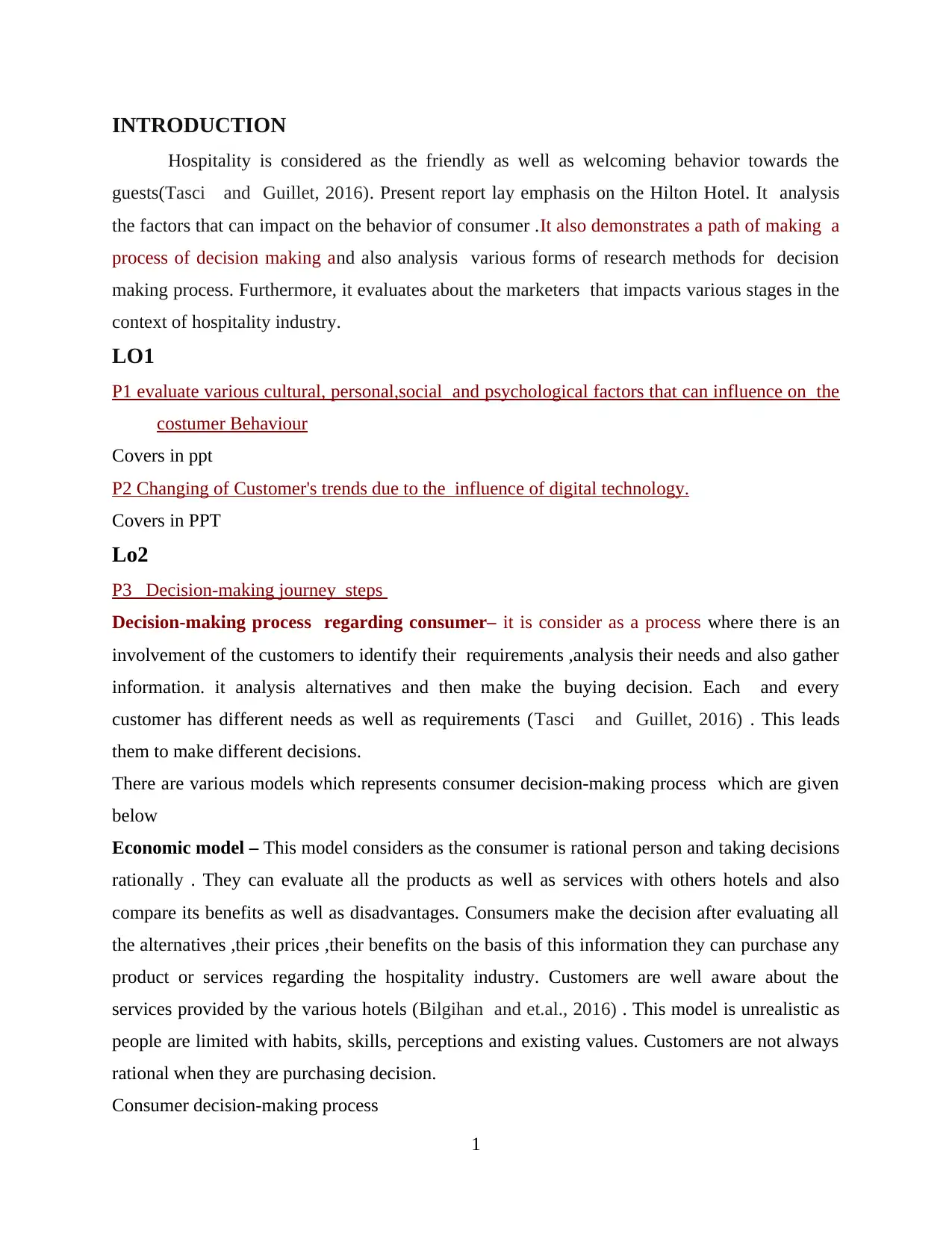
INTRODUCTION
Hospitality is considered as the friendly as well as welcoming behavior towards the
guests(Tasci and Guillet, 2016). Present report lay emphasis on the Hilton Hotel. It analysis
the factors that can impact on the behavior of consumer .It also demonstrates a path of making a
process of decision making and also analysis various forms of research methods for decision
making process. Furthermore, it evaluates about the marketers that impacts various stages in the
context of hospitality industry.
LO1
P1 evaluate various cultural, personal,social and psychological factors that can influence on the
costumer Behaviour
Covers in ppt
P2 Changing of Customer's trends due to the influence of digital technology.
Covers in PPT
Lo2
P3 Decision-making journey steps
Decision-making process regarding consumer– it is consider as a process where there is an
involvement of the customers to identify their requirements ,analysis their needs and also gather
information. it analysis alternatives and then make the buying decision. Each and every
customer has different needs as well as requirements (Tasci and Guillet, 2016) . This leads
them to make different decisions.
There are various models which represents consumer decision-making process which are given
below
Economic model – This model considers as the consumer is rational person and taking decisions
rationally . They can evaluate all the products as well as services with others hotels and also
compare its benefits as well as disadvantages. Consumers make the decision after evaluating all
the alternatives ,their prices ,their benefits on the basis of this information they can purchase any
product or services regarding the hospitality industry. Customers are well aware about the
services provided by the various hotels (Bilgihan and et.al., 2016) . This model is unrealistic as
people are limited with habits, skills, perceptions and existing values. Customers are not always
rational when they are purchasing decision.
Consumer decision-making process
1
Hospitality is considered as the friendly as well as welcoming behavior towards the
guests(Tasci and Guillet, 2016). Present report lay emphasis on the Hilton Hotel. It analysis
the factors that can impact on the behavior of consumer .It also demonstrates a path of making a
process of decision making and also analysis various forms of research methods for decision
making process. Furthermore, it evaluates about the marketers that impacts various stages in the
context of hospitality industry.
LO1
P1 evaluate various cultural, personal,social and psychological factors that can influence on the
costumer Behaviour
Covers in ppt
P2 Changing of Customer's trends due to the influence of digital technology.
Covers in PPT
Lo2
P3 Decision-making journey steps
Decision-making process regarding consumer– it is consider as a process where there is an
involvement of the customers to identify their requirements ,analysis their needs and also gather
information. it analysis alternatives and then make the buying decision. Each and every
customer has different needs as well as requirements (Tasci and Guillet, 2016) . This leads
them to make different decisions.
There are various models which represents consumer decision-making process which are given
below
Economic model – This model considers as the consumer is rational person and taking decisions
rationally . They can evaluate all the products as well as services with others hotels and also
compare its benefits as well as disadvantages. Consumers make the decision after evaluating all
the alternatives ,their prices ,their benefits on the basis of this information they can purchase any
product or services regarding the hospitality industry. Customers are well aware about the
services provided by the various hotels (Bilgihan and et.al., 2016) . This model is unrealistic as
people are limited with habits, skills, perceptions and existing values. Customers are not always
rational when they are purchasing decision.
Consumer decision-making process
1
⊘ This is a preview!⊘
Do you want full access?
Subscribe today to unlock all pages.

Trusted by 1+ million students worldwide
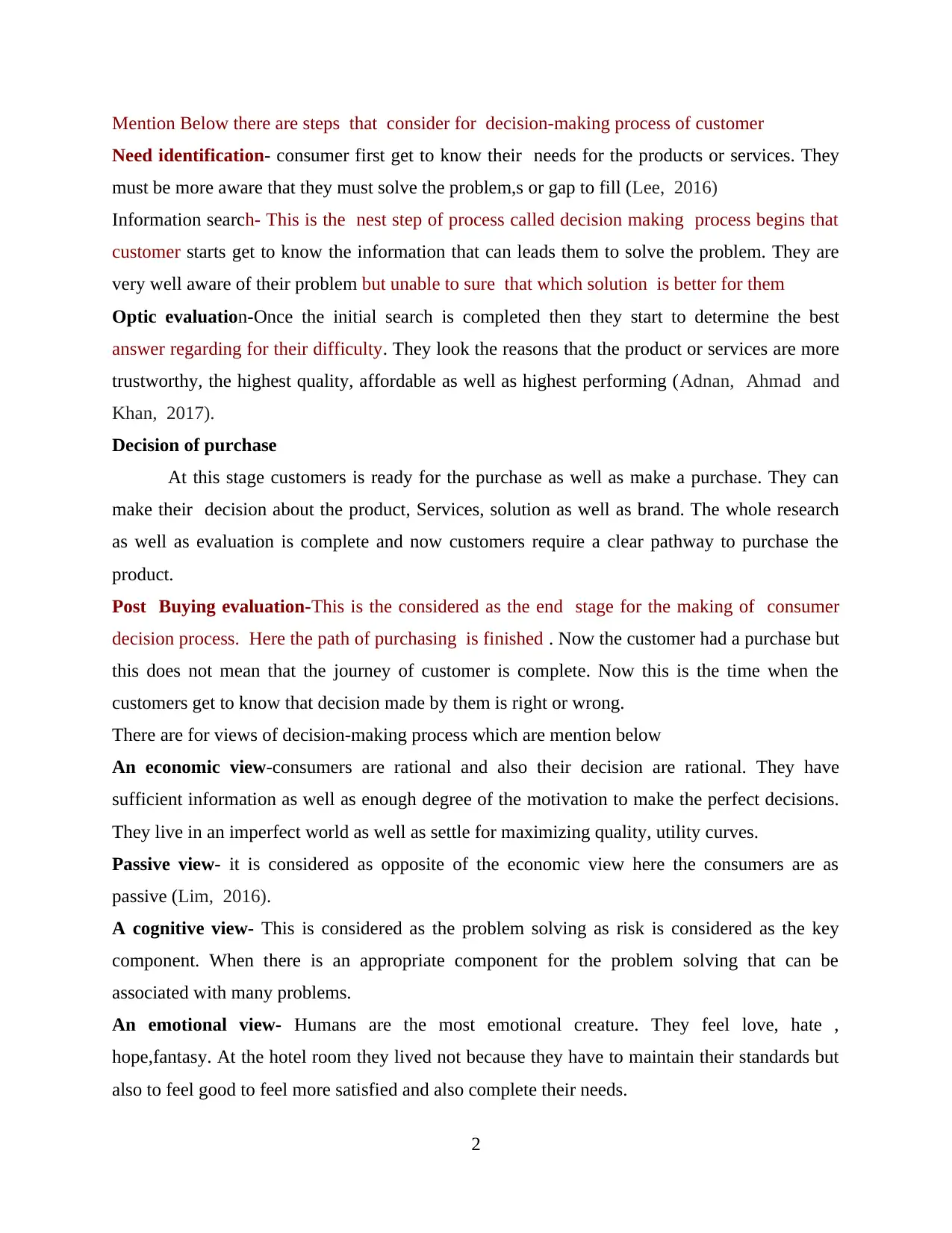
Mention Below there are steps that consider for decision-making process of customer
Need identification- consumer first get to know their needs for the products or services. They
must be more aware that they must solve the problem,s or gap to fill (Lee, 2016)
Information search- This is the nest step of process called decision making process begins that
customer starts get to know the information that can leads them to solve the problem. They are
very well aware of their problem but unable to sure that which solution is better for them
Optic evaluation-Once the initial search is completed then they start to determine the best
answer regarding for their difficulty. They look the reasons that the product or services are more
trustworthy, the highest quality, affordable as well as highest performing (Adnan, Ahmad and
Khan, 2017).
Decision of purchase
At this stage customers is ready for the purchase as well as make a purchase. They can
make their decision about the product, Services, solution as well as brand. The whole research
as well as evaluation is complete and now customers require a clear pathway to purchase the
product.
Post Buying evaluation-This is the considered as the end stage for the making of consumer
decision process. Here the path of purchasing is finished . Now the customer had a purchase but
this does not mean that the journey of customer is complete. Now this is the time when the
customers get to know that decision made by them is right or wrong.
There are for views of decision-making process which are mention below
An economic view-consumers are rational and also their decision are rational. They have
sufficient information as well as enough degree of the motivation to make the perfect decisions.
They live in an imperfect world as well as settle for maximizing quality, utility curves.
Passive view- it is considered as opposite of the economic view here the consumers are as
passive (Lim, 2016).
A cognitive view- This is considered as the problem solving as risk is considered as the key
component. When there is an appropriate component for the problem solving that can be
associated with many problems.
An emotional view- Humans are the most emotional creature. They feel love, hate ,
hope,fantasy. At the hotel room they lived not because they have to maintain their standards but
also to feel good to feel more satisfied and also complete their needs.
2
Need identification- consumer first get to know their needs for the products or services. They
must be more aware that they must solve the problem,s or gap to fill (Lee, 2016)
Information search- This is the nest step of process called decision making process begins that
customer starts get to know the information that can leads them to solve the problem. They are
very well aware of their problem but unable to sure that which solution is better for them
Optic evaluation-Once the initial search is completed then they start to determine the best
answer regarding for their difficulty. They look the reasons that the product or services are more
trustworthy, the highest quality, affordable as well as highest performing (Adnan, Ahmad and
Khan, 2017).
Decision of purchase
At this stage customers is ready for the purchase as well as make a purchase. They can
make their decision about the product, Services, solution as well as brand. The whole research
as well as evaluation is complete and now customers require a clear pathway to purchase the
product.
Post Buying evaluation-This is the considered as the end stage for the making of consumer
decision process. Here the path of purchasing is finished . Now the customer had a purchase but
this does not mean that the journey of customer is complete. Now this is the time when the
customers get to know that decision made by them is right or wrong.
There are for views of decision-making process which are mention below
An economic view-consumers are rational and also their decision are rational. They have
sufficient information as well as enough degree of the motivation to make the perfect decisions.
They live in an imperfect world as well as settle for maximizing quality, utility curves.
Passive view- it is considered as opposite of the economic view here the consumers are as
passive (Lim, 2016).
A cognitive view- This is considered as the problem solving as risk is considered as the key
component. When there is an appropriate component for the problem solving that can be
associated with many problems.
An emotional view- Humans are the most emotional creature. They feel love, hate ,
hope,fantasy. At the hotel room they lived not because they have to maintain their standards but
also to feel good to feel more satisfied and also complete their needs.
2
Paraphrase This Document
Need a fresh take? Get an instant paraphrase of this document with our AI Paraphraser
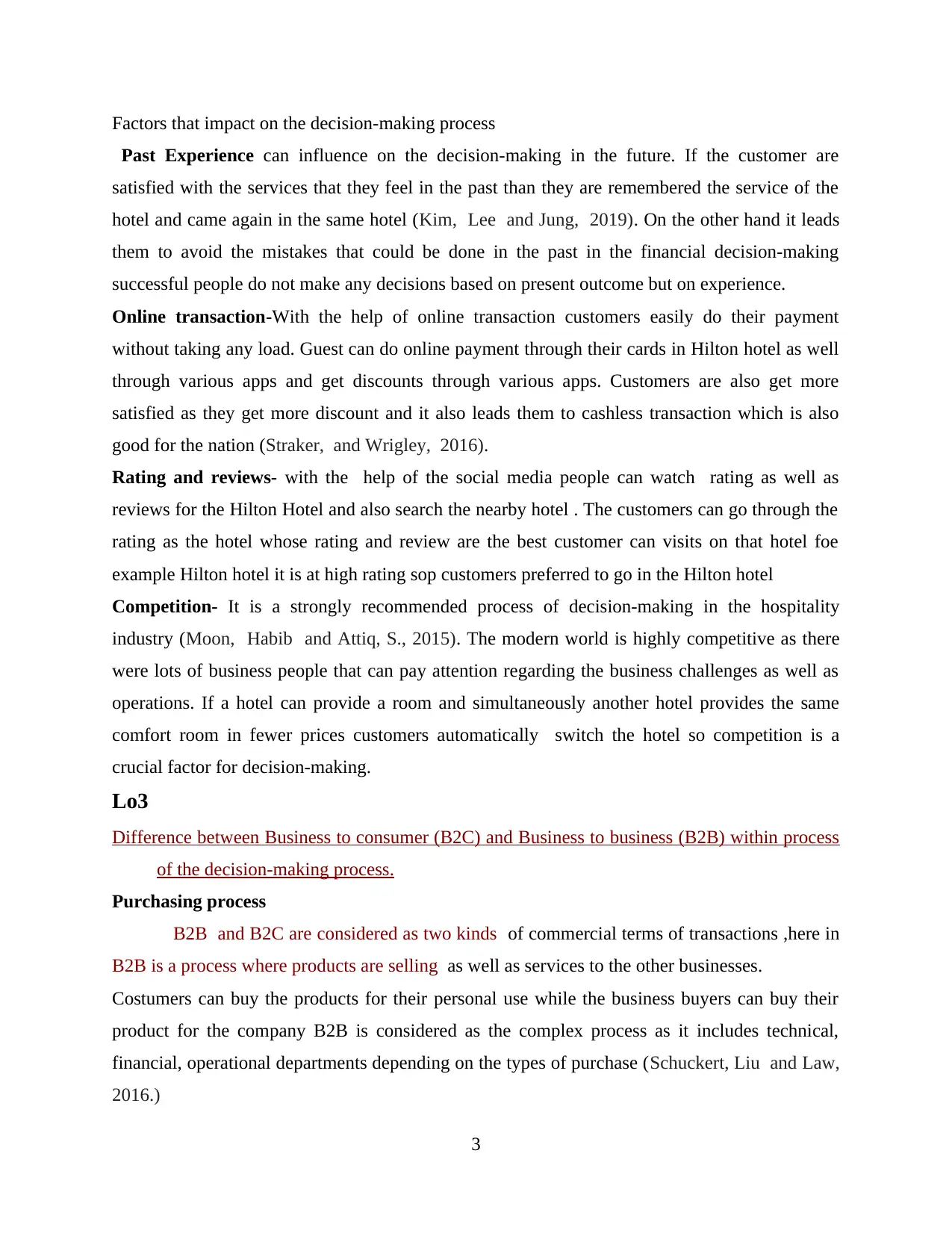
Factors that impact on the decision-making process
Past Experience can influence on the decision-making in the future. If the customer are
satisfied with the services that they feel in the past than they are remembered the service of the
hotel and came again in the same hotel (Kim, Lee and Jung, 2019). On the other hand it leads
them to avoid the mistakes that could be done in the past in the financial decision-making
successful people do not make any decisions based on present outcome but on experience.
Online transaction-With the help of online transaction customers easily do their payment
without taking any load. Guest can do online payment through their cards in Hilton hotel as well
through various apps and get discounts through various apps. Customers are also get more
satisfied as they get more discount and it also leads them to cashless transaction which is also
good for the nation (Straker, and Wrigley, 2016).
Rating and reviews- with the help of the social media people can watch rating as well as
reviews for the Hilton Hotel and also search the nearby hotel . The customers can go through the
rating as the hotel whose rating and review are the best customer can visits on that hotel foe
example Hilton hotel it is at high rating sop customers preferred to go in the Hilton hotel
Competition- It is a strongly recommended process of decision-making in the hospitality
industry (Moon, Habib and Attiq, S., 2015). The modern world is highly competitive as there
were lots of business people that can pay attention regarding the business challenges as well as
operations. If a hotel can provide a room and simultaneously another hotel provides the same
comfort room in fewer prices customers automatically switch the hotel so competition is a
crucial factor for decision-making.
Lo3
Difference between Business to consumer (B2C) and Business to business (B2B) within process
of the decision-making process.
Purchasing process
B2B and B2C are considered as two kinds of commercial terms of transactions ,here in
B2B is a process where products are selling as well as services to the other businesses.
Costumers can buy the products for their personal use while the business buyers can buy their
product for the company B2B is considered as the complex process as it includes technical,
financial, operational departments depending on the types of purchase (Schuckert, Liu and Law,
2016.)
3
Past Experience can influence on the decision-making in the future. If the customer are
satisfied with the services that they feel in the past than they are remembered the service of the
hotel and came again in the same hotel (Kim, Lee and Jung, 2019). On the other hand it leads
them to avoid the mistakes that could be done in the past in the financial decision-making
successful people do not make any decisions based on present outcome but on experience.
Online transaction-With the help of online transaction customers easily do their payment
without taking any load. Guest can do online payment through their cards in Hilton hotel as well
through various apps and get discounts through various apps. Customers are also get more
satisfied as they get more discount and it also leads them to cashless transaction which is also
good for the nation (Straker, and Wrigley, 2016).
Rating and reviews- with the help of the social media people can watch rating as well as
reviews for the Hilton Hotel and also search the nearby hotel . The customers can go through the
rating as the hotel whose rating and review are the best customer can visits on that hotel foe
example Hilton hotel it is at high rating sop customers preferred to go in the Hilton hotel
Competition- It is a strongly recommended process of decision-making in the hospitality
industry (Moon, Habib and Attiq, S., 2015). The modern world is highly competitive as there
were lots of business people that can pay attention regarding the business challenges as well as
operations. If a hotel can provide a room and simultaneously another hotel provides the same
comfort room in fewer prices customers automatically switch the hotel so competition is a
crucial factor for decision-making.
Lo3
Difference between Business to consumer (B2C) and Business to business (B2B) within process
of the decision-making process.
Purchasing process
B2B and B2C are considered as two kinds of commercial terms of transactions ,here in
B2B is a process where products are selling as well as services to the other businesses.
Costumers can buy the products for their personal use while the business buyers can buy their
product for the company B2B is considered as the complex process as it includes technical,
financial, operational departments depending on the types of purchase (Schuckert, Liu and Law,
2016.)
3
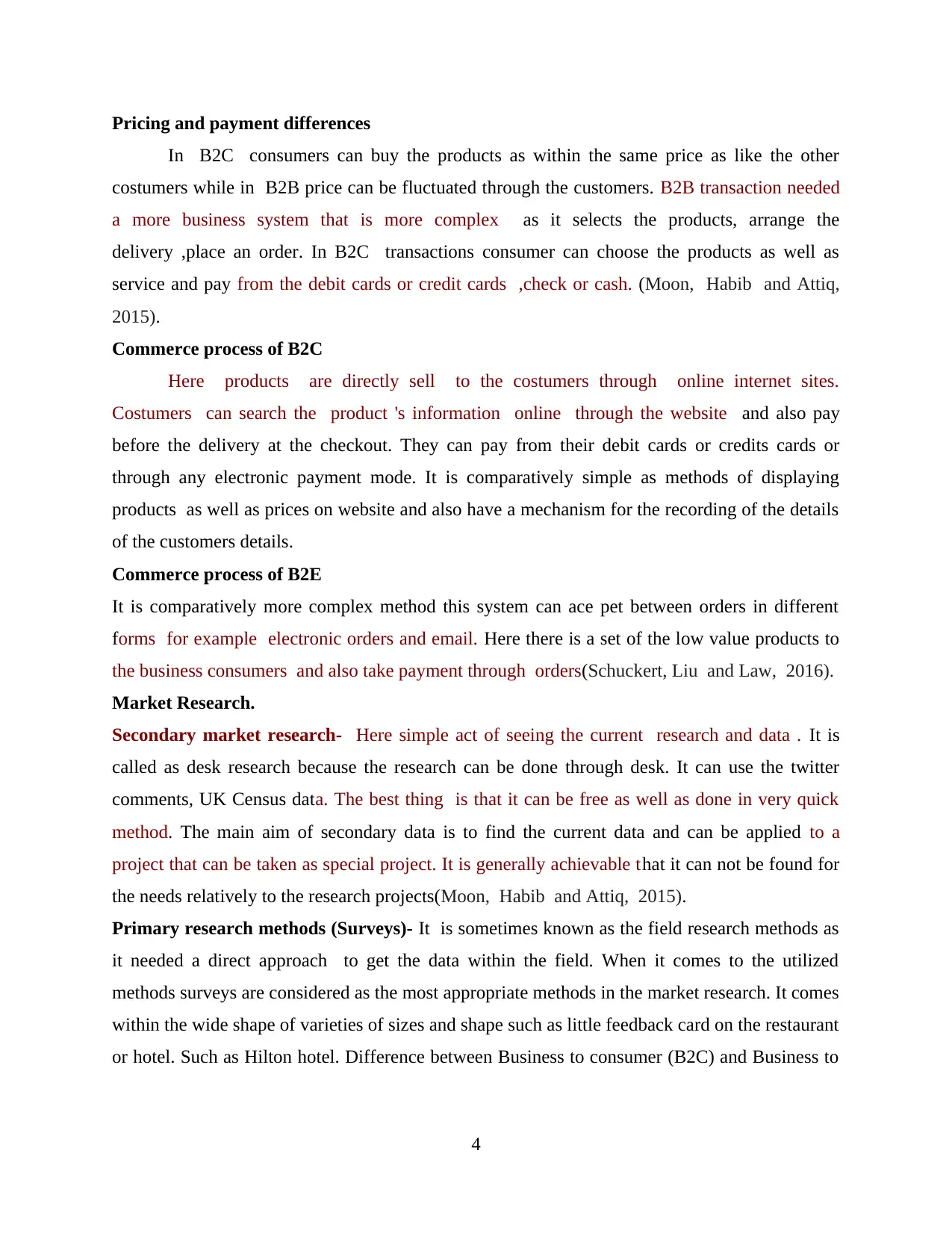
Pricing and payment differences
In B2C consumers can buy the products as within the same price as like the other
costumers while in B2B price can be fluctuated through the customers. B2B transaction needed
a more business system that is more complex as it selects the products, arrange the
delivery ,place an order. In B2C transactions consumer can choose the products as well as
service and pay from the debit cards or credit cards ,check or cash. (Moon, Habib and Attiq,
2015).
Commerce process of B2C
Here products are directly sell to the costumers through online internet sites.
Costumers can search the product 's information online through the website and also pay
before the delivery at the checkout. They can pay from their debit cards or credits cards or
through any electronic payment mode. It is comparatively simple as methods of displaying
products as well as prices on website and also have a mechanism for the recording of the details
of the customers details.
Commerce process of B2E
It is comparatively more complex method this system can ace pet between orders in different
forms for example electronic orders and email. Here there is a set of the low value products to
the business consumers and also take payment through orders(Schuckert, Liu and Law, 2016).
Market Research.
Secondary market research- Here simple act of seeing the current research and data . It is
called as desk research because the research can be done through desk. It can use the twitter
comments, UK Census data. The best thing is that it can be free as well as done in very quick
method. The main aim of secondary data is to find the current data and can be applied to a
project that can be taken as special project. It is generally achievable that it can not be found for
the needs relatively to the research projects(Moon, Habib and Attiq, 2015).
Primary research methods (Surveys)- It is sometimes known as the field research methods as
it needed a direct approach to get the data within the field. When it comes to the utilized
methods surveys are considered as the most appropriate methods in the market research. It comes
within the wide shape of varieties of sizes and shape such as little feedback card on the restaurant
or hotel. Such as Hilton hotel. Difference between Business to consumer (B2C) and Business to
4
In B2C consumers can buy the products as within the same price as like the other
costumers while in B2B price can be fluctuated through the customers. B2B transaction needed
a more business system that is more complex as it selects the products, arrange the
delivery ,place an order. In B2C transactions consumer can choose the products as well as
service and pay from the debit cards or credit cards ,check or cash. (Moon, Habib and Attiq,
2015).
Commerce process of B2C
Here products are directly sell to the costumers through online internet sites.
Costumers can search the product 's information online through the website and also pay
before the delivery at the checkout. They can pay from their debit cards or credits cards or
through any electronic payment mode. It is comparatively simple as methods of displaying
products as well as prices on website and also have a mechanism for the recording of the details
of the customers details.
Commerce process of B2E
It is comparatively more complex method this system can ace pet between orders in different
forms for example electronic orders and email. Here there is a set of the low value products to
the business consumers and also take payment through orders(Schuckert, Liu and Law, 2016).
Market Research.
Secondary market research- Here simple act of seeing the current research and data . It is
called as desk research because the research can be done through desk. It can use the twitter
comments, UK Census data. The best thing is that it can be free as well as done in very quick
method. The main aim of secondary data is to find the current data and can be applied to a
project that can be taken as special project. It is generally achievable that it can not be found for
the needs relatively to the research projects(Moon, Habib and Attiq, 2015).
Primary research methods (Surveys)- It is sometimes known as the field research methods as
it needed a direct approach to get the data within the field. When it comes to the utilized
methods surveys are considered as the most appropriate methods in the market research. It comes
within the wide shape of varieties of sizes and shape such as little feedback card on the restaurant
or hotel. Such as Hilton hotel. Difference between Business to consumer (B2C) and Business to
4
⊘ This is a preview!⊘
Do you want full access?
Subscribe today to unlock all pages.

Trusted by 1+ million students worldwide
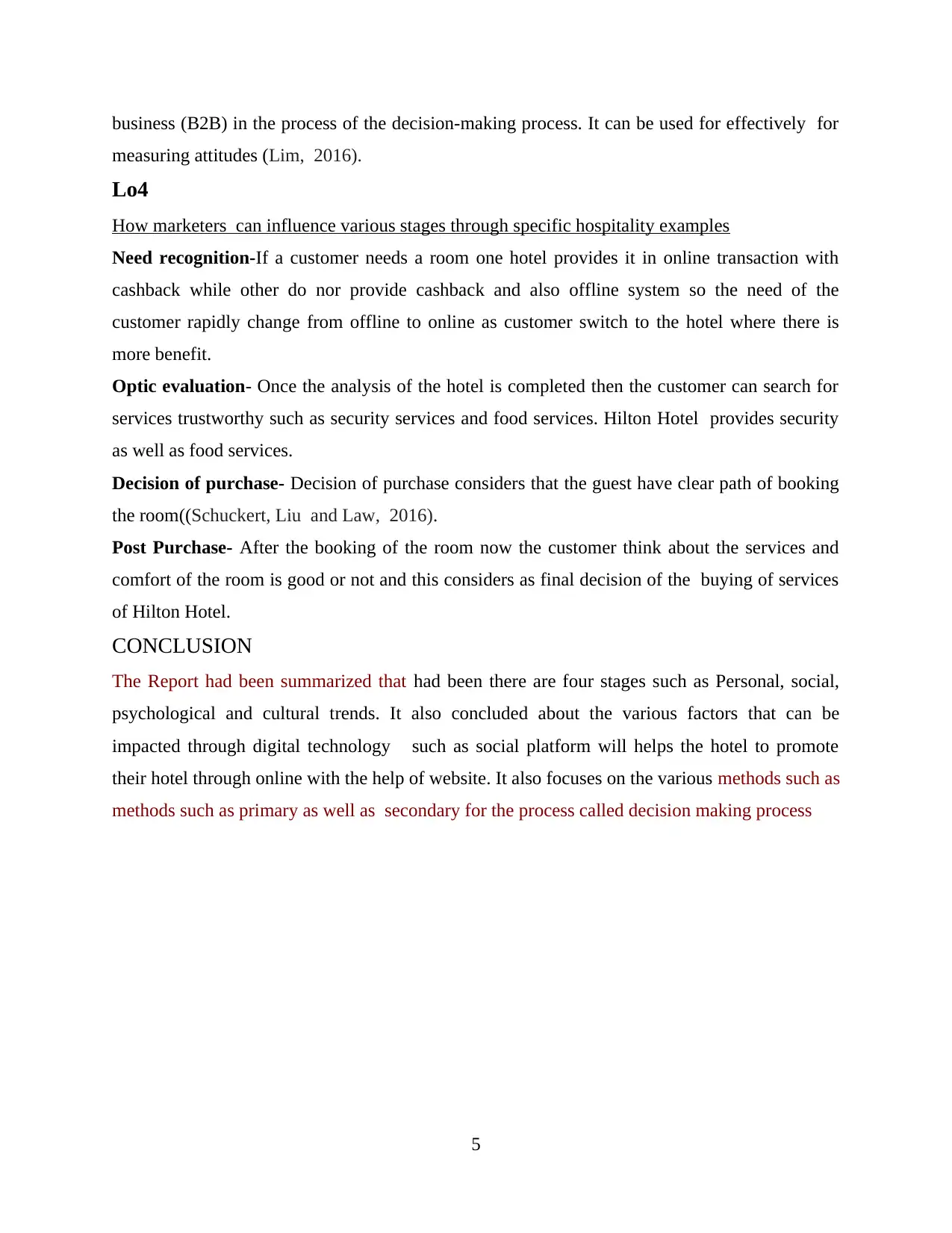
business (B2B) in the process of the decision-making process. It can be used for effectively for
measuring attitudes (Lim, 2016).
Lo4
How marketers can influence various stages through specific hospitality examples
Need recognition-If a customer needs a room one hotel provides it in online transaction with
cashback while other do nor provide cashback and also offline system so the need of the
customer rapidly change from offline to online as customer switch to the hotel where there is
more benefit.
Optic evaluation- Once the analysis of the hotel is completed then the customer can search for
services trustworthy such as security services and food services. Hilton Hotel provides security
as well as food services.
Decision of purchase- Decision of purchase considers that the guest have clear path of booking
the room((Schuckert, Liu and Law, 2016).
Post Purchase- After the booking of the room now the customer think about the services and
comfort of the room is good or not and this considers as final decision of the buying of services
of Hilton Hotel.
CONCLUSION
The Report had been summarized that had been there are four stages such as Personal, social,
psychological and cultural trends. It also concluded about the various factors that can be
impacted through digital technology such as social platform will helps the hotel to promote
their hotel through online with the help of website. It also focuses on the various methods such as
methods such as primary as well as secondary for the process called decision making process
5
measuring attitudes (Lim, 2016).
Lo4
How marketers can influence various stages through specific hospitality examples
Need recognition-If a customer needs a room one hotel provides it in online transaction with
cashback while other do nor provide cashback and also offline system so the need of the
customer rapidly change from offline to online as customer switch to the hotel where there is
more benefit.
Optic evaluation- Once the analysis of the hotel is completed then the customer can search for
services trustworthy such as security services and food services. Hilton Hotel provides security
as well as food services.
Decision of purchase- Decision of purchase considers that the guest have clear path of booking
the room((Schuckert, Liu and Law, 2016).
Post Purchase- After the booking of the room now the customer think about the services and
comfort of the room is good or not and this considers as final decision of the buying of services
of Hilton Hotel.
CONCLUSION
The Report had been summarized that had been there are four stages such as Personal, social,
psychological and cultural trends. It also concluded about the various factors that can be
impacted through digital technology such as social platform will helps the hotel to promote
their hotel through online with the help of website. It also focuses on the various methods such as
methods such as primary as well as secondary for the process called decision making process
5
Paraphrase This Document
Need a fresh take? Get an instant paraphrase of this document with our AI Paraphraser
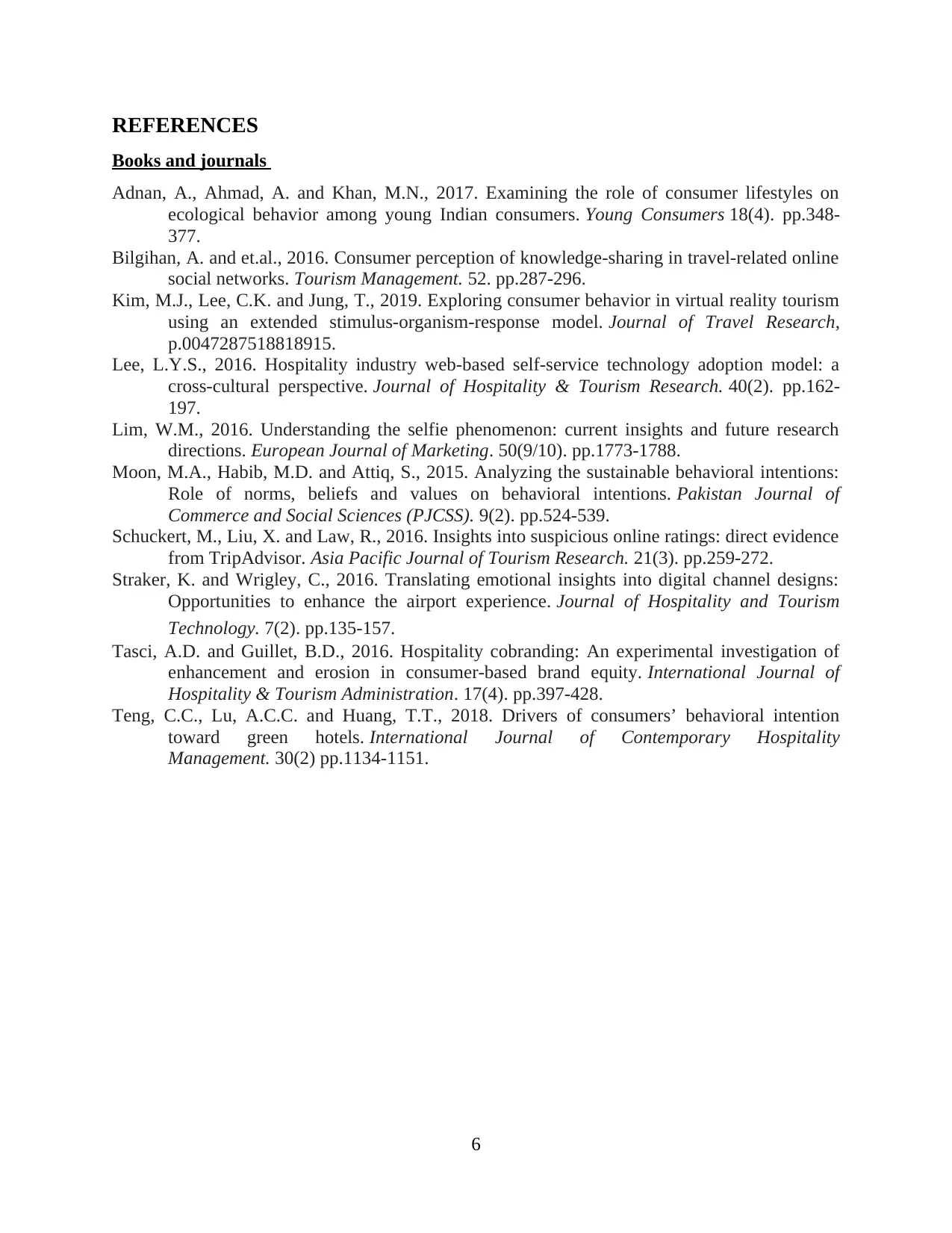
REFERENCES
Books and journals
Adnan, A., Ahmad, A. and Khan, M.N., 2017. Examining the role of consumer lifestyles on
ecological behavior among young Indian consumers. Young Consumers 18(4). pp.348-
377.
Bilgihan, A. and et.al., 2016. Consumer perception of knowledge-sharing in travel-related online
social networks. Tourism Management. 52. pp.287-296.
Kim, M.J., Lee, C.K. and Jung, T., 2019. Exploring consumer behavior in virtual reality tourism
using an extended stimulus-organism-response model. Journal of Travel Research,
p.0047287518818915.
Lee, L.Y.S., 2016. Hospitality industry web-based self-service technology adoption model: a
cross-cultural perspective. Journal of Hospitality & Tourism Research. 40(2). pp.162-
197.
Lim, W.M., 2016. Understanding the selfie phenomenon: current insights and future research
directions. European Journal of Marketing. 50(9/10). pp.1773-1788.
Moon, M.A., Habib, M.D. and Attiq, S., 2015. Analyzing the sustainable behavioral intentions:
Role of norms, beliefs and values on behavioral intentions. Pakistan Journal of
Commerce and Social Sciences (PJCSS). 9(2). pp.524-539.
Schuckert, M., Liu, X. and Law, R., 2016. Insights into suspicious online ratings: direct evidence
from TripAdvisor. Asia Pacific Journal of Tourism Research. 21(3). pp.259-272.
Straker, K. and Wrigley, C., 2016. Translating emotional insights into digital channel designs:
Opportunities to enhance the airport experience. Journal of Hospitality and Tourism
Technology. 7(2). pp.135-157.
Tasci, A.D. and Guillet, B.D., 2016. Hospitality cobranding: An experimental investigation of
enhancement and erosion in consumer-based brand equity. International Journal of
Hospitality & Tourism Administration. 17(4). pp.397-428.
Teng, C.C., Lu, A.C.C. and Huang, T.T., 2018. Drivers of consumers’ behavioral intention
toward green hotels. International Journal of Contemporary Hospitality
Management. 30(2) pp.1134-1151.
6
Books and journals
Adnan, A., Ahmad, A. and Khan, M.N., 2017. Examining the role of consumer lifestyles on
ecological behavior among young Indian consumers. Young Consumers 18(4). pp.348-
377.
Bilgihan, A. and et.al., 2016. Consumer perception of knowledge-sharing in travel-related online
social networks. Tourism Management. 52. pp.287-296.
Kim, M.J., Lee, C.K. and Jung, T., 2019. Exploring consumer behavior in virtual reality tourism
using an extended stimulus-organism-response model. Journal of Travel Research,
p.0047287518818915.
Lee, L.Y.S., 2016. Hospitality industry web-based self-service technology adoption model: a
cross-cultural perspective. Journal of Hospitality & Tourism Research. 40(2). pp.162-
197.
Lim, W.M., 2016. Understanding the selfie phenomenon: current insights and future research
directions. European Journal of Marketing. 50(9/10). pp.1773-1788.
Moon, M.A., Habib, M.D. and Attiq, S., 2015. Analyzing the sustainable behavioral intentions:
Role of norms, beliefs and values on behavioral intentions. Pakistan Journal of
Commerce and Social Sciences (PJCSS). 9(2). pp.524-539.
Schuckert, M., Liu, X. and Law, R., 2016. Insights into suspicious online ratings: direct evidence
from TripAdvisor. Asia Pacific Journal of Tourism Research. 21(3). pp.259-272.
Straker, K. and Wrigley, C., 2016. Translating emotional insights into digital channel designs:
Opportunities to enhance the airport experience. Journal of Hospitality and Tourism
Technology. 7(2). pp.135-157.
Tasci, A.D. and Guillet, B.D., 2016. Hospitality cobranding: An experimental investigation of
enhancement and erosion in consumer-based brand equity. International Journal of
Hospitality & Tourism Administration. 17(4). pp.397-428.
Teng, C.C., Lu, A.C.C. and Huang, T.T., 2018. Drivers of consumers’ behavioral intention
toward green hotels. International Journal of Contemporary Hospitality
Management. 30(2) pp.1134-1151.
6
1 out of 8
Related Documents
Your All-in-One AI-Powered Toolkit for Academic Success.
+13062052269
info@desklib.com
Available 24*7 on WhatsApp / Email
![[object Object]](/_next/static/media/star-bottom.7253800d.svg)
Unlock your academic potential
Copyright © 2020–2025 A2Z Services. All Rights Reserved. Developed and managed by ZUCOL.




